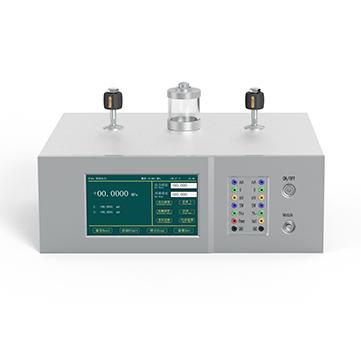Working Principle of Fully Automatic Pressure Calibrator
The fully automatic pressure calibrator is an instrument used for calibrating and verifying pressure measuring device such as pressure gauges, pressure sensors, and pressure transmitters. It can automatically generate, control, and measure pressure to ensure the accuracy and reliability of the calibrated device. The following is the working principle of the fully automatic pressure calibrator:
1. Pressure source
Fully automatic pressure calibrators are usually equipped with a built-in pressure source, which can be pneumatic or hydraulic. The pressure source is responsible for generating the required pressure range for calibration.
2. Pressure control
The calibrator has a precise pressure control system inside, which can accurately control pressure through components such as electric regulating valves, booster pumps, or pressure reducing valves. Users can set the target pressure value through the operation interface, and the system will automatically adjust the pressure source output to achieve the set value.
3. Pressure measurement
The calibrator is equipped with a high-precision pressure sensor for real-time measurement of the current pressure value. These sensors typically have high precision and stability, providing accurate pressure readings.
4. Data processing and display
The microprocessor of the calibrator processes the signal from the pressure sensor, converts it into a readable pressure value, and displays it on the screen. Users can view and set pressure parameters through the touch screen or button operation interface.
5. Automatic calibration
In automatic calibration mode, the calibrator will automatically generate a series of pressure points according to the preset calibration program and record the response of the calibrated equipment at each pressure point. The calibrator can automatically calculate the error of the calibrated equipment and generate a calibration report.
6. Communication interface
Many fully automatic pressure calibrators are equipped with multiple communication interfaces (such as USB, RS232, GPIB, or Ethernet) that can be connected to computers or other devices for data transmission and remote control.
7. Software support
Calibration instruments are usually equipped with specialized software that can record, analyze, and generate reports of data. Users can perform more complex calibration tasks and data management through software.
8. Safety features
In order to ensure operational safety, the calibrator usually has safety functions such as overvoltage protection, pressure relief, and emergency stop button to prevent deivce damage or personnel injury.
Work Procedure Example
1.Set calibration parameters: Users can set the target pressure range and calibration point through the operation interface.
2.Generate pressure: The calibrator automatically controls the pressure source to generate the required pressure.
3.Measuring pressure: The built-in sensor measures pressure in real-time and compares it with the target value.
4.Record data: The calibrator automatically records the readings of the calibrated equipment at each calibration point.
5.Calculation error: The calibrator calculates the error of the calibrated equipment and generates a calibration report.
Through these steps, the fully automatic pressure calibrator can efficiently and accurately complete the calibration task of pressure measuring equipment.
1. Pressure source
Fully automatic pressure calibrators are usually equipped with a built-in pressure source, which can be pneumatic or hydraulic. The pressure source is responsible for generating the required pressure range for calibration.
2. Pressure control
The calibrator has a precise pressure control system inside, which can accurately control pressure through components such as electric regulating valves, booster pumps, or pressure reducing valves. Users can set the target pressure value through the operation interface, and the system will automatically adjust the pressure source output to achieve the set value.
3. Pressure measurement
The calibrator is equipped with a high-precision pressure sensor for real-time measurement of the current pressure value. These sensors typically have high precision and stability, providing accurate pressure readings.
4. Data processing and display
The microprocessor of the calibrator processes the signal from the pressure sensor, converts it into a readable pressure value, and displays it on the screen. Users can view and set pressure parameters through the touch screen or button operation interface.
5. Automatic calibration
In automatic calibration mode, the calibrator will automatically generate a series of pressure points according to the preset calibration program and record the response of the calibrated equipment at each pressure point. The calibrator can automatically calculate the error of the calibrated equipment and generate a calibration report.
6. Communication interface
Many fully automatic pressure calibrators are equipped with multiple communication interfaces (such as USB, RS232, GPIB, or Ethernet) that can be connected to computers or other devices for data transmission and remote control.
7. Software support
Calibration instruments are usually equipped with specialized software that can record, analyze, and generate reports of data. Users can perform more complex calibration tasks and data management through software.
8. Safety features
In order to ensure operational safety, the calibrator usually has safety functions such as overvoltage protection, pressure relief, and emergency stop button to prevent deivce damage or personnel injury.
Work Procedure Example
1.Set calibration parameters: Users can set the target pressure range and calibration point through the operation interface.
2.Generate pressure: The calibrator automatically controls the pressure source to generate the required pressure.
3.Measuring pressure: The built-in sensor measures pressure in real-time and compares it with the target value.
4.Record data: The calibrator automatically records the readings of the calibrated equipment at each calibration point.
5.Calculation error: The calibrator calculates the error of the calibrated equipment and generates a calibration report.
Through these steps, the fully automatic pressure calibrator can efficiently and accurately complete the calibration task of pressure measuring equipment.
